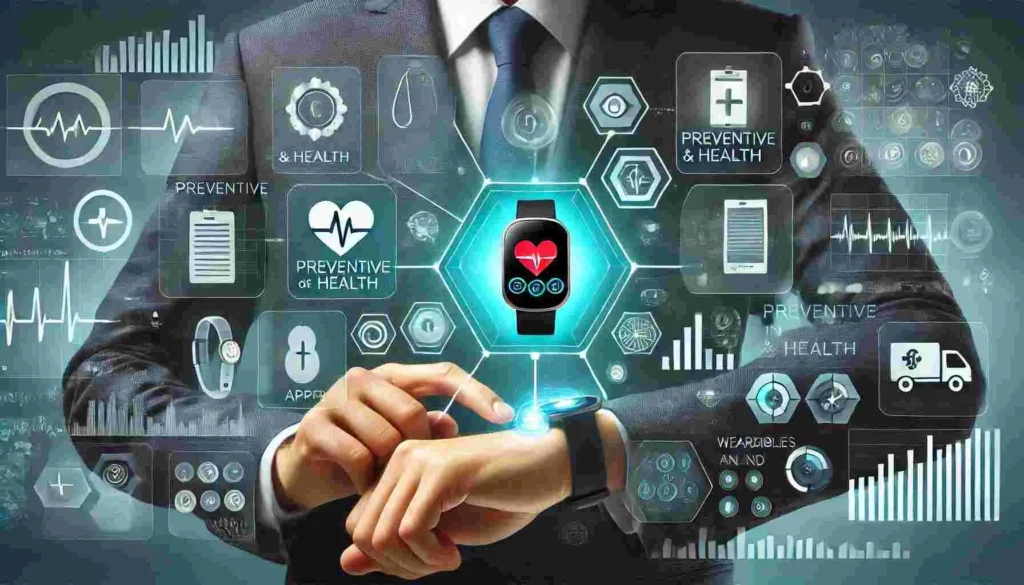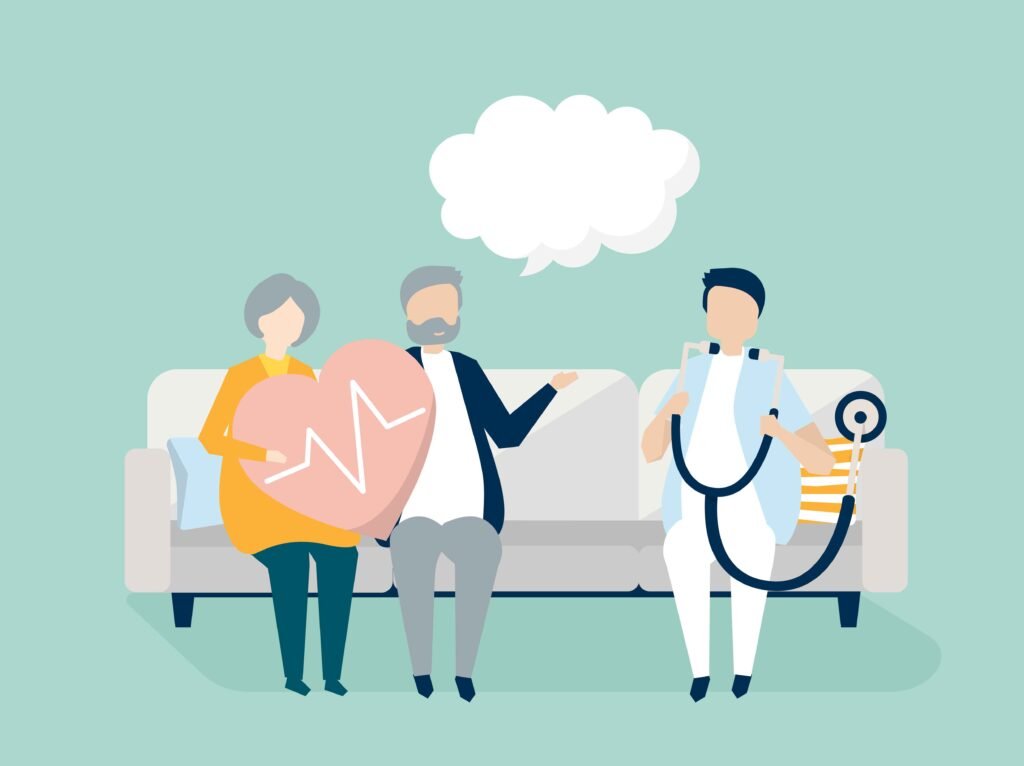
The Role of Technology in Preventive Health: Wearables and Apps
Introduction
Preventive health has become a cornerstone of modern medicine, emphasizing proactive measures to maintain well-being and avoid illnesses. With the rise of technology, wearables and health apps are revolutionizing how individuals engage with their health, making prevention more accessible and personalized. These tools empower people to monitor their physical activity, manage chronic conditions, and adopt healthier lifestyles.
This blog post explores how wearables and apps contribute to preventive health, the key features driving their success, and the benefits they offer in reshaping health care.
The Evolution of Preventive Health
From Reactive to Proactive Care
Traditionally, healthcare focused on diagnosing and treating illnesses after they occurred. Preventive health, however, shifts this paradigm by encouraging individuals to take charge of their health before problems arise. This approach involves regular screenings, healthy lifestyle choices, and leveraging cutting-edge technology to stay ahead of potential health risks.
Wearables and apps bridge the gap between daily habits and long-term health outcomes, providing real-time feedback and actionable insights.
The Role of Technology in Shaping Preventive Health
Technology has redefined the way we approach health by offering tools that are both innovative and user-friendly. Wearable devices, such as fitness trackers and smartwatches, are equipped with sensors to monitor metrics like heart rate, sleep patterns, and activity levels.
Meanwhile, health apps serve as virtual health coaches, offering personalized recommendations, reminders, and educational content. Together, these tools make it easier for individuals to stay informed and motivated.
The Impact of Wearables on Preventive Health
Tracking Vital Signs and Activity Levels
Wearables have transformed personal health tracking into an effortless daily routine. Devices like Fitbit, Garmin, and Apple Watch provide users with valuable insights into their physical activity, calorie expenditure, and heart rate.
Key features include:
- Continuous Heart Rate Monitoring: Alerts users to irregularities, prompting timely medical attention.
- Step Counters: Encourage physical activity, reducing risks associated with a sedentary lifestyle.
- Sleep Tracking: Helps users identify patterns and improve sleep quality, a vital aspect of preventive health.
By offering consistent feedback, wearables motivate users to achieve their health goals and adopt healthier behaviors.
Early Detection of Health Risks
Many wearables now integrate advanced features like ECG monitoring, oxygen saturation levels, and stress tracking. These capabilities can identify early signs of cardiovascular issues, respiratory problems, and mental health concerns.
For example, the Apple Watch has been credited with detecting atrial fibrillation in users, potentially saving lives by enabling early intervention. This proactive approach aligns with the core principles of preventive health.
Empowering Users with Health Apps
Personalized Health Management
Health apps complement wearables by providing users with tailored guidance and actionable insights. These apps often allow users to log their dietary habits, monitor water intake, and set fitness goals. Popular examples include:
- MyFitnessPal: Tracks calories and nutritional intake to encourage healthier eating habits.
- Headspace: Focuses on mental health through guided meditation and stress relief exercises.
- Nike Training Club: Offers workout plans for all fitness levels.
These apps create an ecosystem of support, helping users make informed choices that align with their preventive health objectives.
Promoting Behavioral Change
Behavioral science plays a pivotal role in preventive health, and apps are leveraging this by incorporating gamification, rewards, and social connectivity. Features like streaks, badges, and leaderboards encourage consistency and competition, fostering long-term adherence to healthy practices.
Wearables and Apps in Managing Chronic Conditions
Revolutionizing Chronic Disease Monitoring
Wearables and health apps are game-changers for individuals managing chronic conditions such as diabetes, hypertension, and heart disease. These tools provide real-time data, empowering users to take control of their health and reducing the risk of complications.
Key examples of their impact include:
- Diabetes Management: Devices like continuous glucose monitors (CGMs) track blood sugar levels throughout the day. Apps linked to CGMs provide actionable insights, helping users manage their diet, insulin intake, and physical activity.
- Blood Pressure Monitoring: Smartwatches with blood pressure sensors allow individuals to detect early signs of hypertension and make timely adjustments to their lifestyle or medication.
- Cardiac Health: Wearables with ECG capabilities, like the Apple Watch, help users monitor their heart rhythm and detect irregularities before they escalate into emergencies.
By integrating these tools into their daily routines, individuals can work collaboratively with healthcare providers to achieve better outcomes.
Enhancing Medication Adherence
One of the biggest challenges in managing chronic conditions is ensuring consistent medication adherence. Apps with reminders, tracking features, and refill alerts significantly improve compliance.
Key features include:
- Smart Reminders: Notifications alert users when it’s time to take their medications.
- Dose Tracking: Apps log each dose to prevent missed or double doses.
- Pharmacy Integration: Users can reorder prescriptions directly through certain health apps.
This seamless integration of technology simplifies the process, ensuring that users stay on track with their treatment plans.
Bridging Gaps in Healthcare Access
Telehealth Integration with Wearables
Wearables and apps are enhancing telehealth services, providing healthcare providers with accurate, real-time patient data. This integration has been especially vital in remote areas where access to healthcare is limited.
Key benefits include:
- Remote Monitoring: Wearables transmit data directly to healthcare providers, enabling timely interventions without in-person visits.
- Virtual Consultations: Health apps support video consultations where doctors can review wearable data to guide treatment decisions.
- Improved Follow-Up Care: Continuous data tracking helps monitor patient progress after consultations.
This synergy between technology and healthcare delivery is paving the way for more inclusive and effective preventive care.
Health Literacy and Awareness
Another crucial role of health apps is improving health literacy. Many apps provide educational content, empowering users with the knowledge they need to make informed decisions.
Features that promote health literacy include:
- Infographics and Tutorials: Simplified explanations of health conditions and preventive measures.
- Goal Setting: Guided steps to achieve health milestones, from weight loss to stress reduction.
- Personalized Tips: Insights based on individual health metrics and habits.
This combination of education and actionable guidance ensures users stay proactive about their health.
Addressing Potential Challenges
Data Privacy and Security
While wearables and apps offer numerous benefits, they also raise concerns about data privacy and security. Sensitive health information must be protected to ensure user trust and compliance with regulations such as GDPR and HIPAA.
Steps to address these concerns include:
- Encryption: Ensuring all health data is securely encrypted during storage and transmission.
- Transparent Privacy Policies: Informing users about how their data will be used and who has access to it.
- Two-Factor Authentication: Adding an extra layer of security to user accounts.
By prioritizing data security, developers can foster greater trust among users.
Over-Reliance on Technology
Another challenge is the potential over-reliance on technology. While wearables and apps provide valuable support, they are not substitutes for professional medical advice or treatment.
To mitigate this, users should:
- Use Tools as Supplements: Rely on apps and wearables for guidance but maintain regular check-ups with healthcare providers.
- Seek Expert Advice: Consult doctors for any abnormal readings or concerns flagged by devices.
- Stay Balanced: Avoid obsessing over health metrics, as this can lead to anxiety or unhealthy behaviors.
Striking a balance between technology and traditional care is essential for maximizing the benefits of preventive health tools.
Accessibility and Cost Barriers
Not everyone has access to wearables and health apps due to cost barriers or lack of technological literacy. Ensuring inclusivity in preventive health technology is crucial for widespread adoption.
Potential solutions include:
- Affordable Devices: Developing budget-friendly wearables with essential features.
- Free Health Apps: Offering basic versions of apps at no cost, with optional premium upgrades.
- Community Outreach: Providing workshops to educate underserved populations on how to use these tools effectively.
By addressing these barriers, technology can become a truly universal ally in preventive health.
The Benefits of Long-Term Adoption
Building Healthier Habits
Consistency is key to preventive health, and wearables and apps are designed to foster long-term habits. By tracking progress, celebrating milestones, and providing continuous feedback, these tools encourage sustainable lifestyle changes.
For example:
- Daily Step Goals: Wearables inspire users to meet step targets, promoting regular physical activity.
- Mindfulness Practices: Apps guide users through stress-relieving techniques like meditation and deep breathing.
- Dietary Improvements: Nutrition trackers help users maintain balanced diets tailored to their individual needs.
Over time, these small but significant changes can lead to profound improvements in overall health.
Enhancing Collaboration with Healthcare Providers
Technology doesn’t replace healthcare professionals but enhances collaboration between patients and providers. With detailed data from wearables and apps, doctors can make more informed decisions, leading to personalized care plans.
Benefits include:
- Comprehensive Health Records: Consolidating data from multiple sources into a single platform for easy access.
- Improved Diagnosis: Real-time data provides a clearer picture of patient health trends.
- Better Communication: Patients can share updates with providers, ensuring continuous care.
This partnership creates a proactive healthcare ecosystem where prevention is prioritized over cure.
The Future of Wearables and Apps in Preventive Health
Advanced Sensors and Real-Time Analytics
The future of wearables lies in the development of advanced sensors capable of providing even more accurate and comprehensive data. These innovations will not only improve current functionalities but also introduce new preventive health capabilities.
Key advancements to expect:
- Non-Invasive Blood Sugar Monitoring: Devices that measure glucose levels without needles will revolutionize diabetes management.
- Hydration Sensors: Wearables that track hydration levels to ensure optimal bodily functions.
- Continuous Blood Pressure Monitoring: More precise and comfortable alternatives to traditional cuffs.
These improvements will empower users with real-time analytics that guide their decisions, ensuring a proactive approach to health maintenance.
AI and Machine Learning in Health Apps
Artificial Intelligence (AI) is set to transform health apps by providing users with highly personalized insights and recommendations. Machine learning algorithms will analyze data patterns to predict health risks and suggest preventive measures tailored to individual needs.
Examples of AI integration:
- Predictive Analytics: Identifying potential health issues based on trends and metrics.
- Customized Workouts: Apps that adapt exercise routines to user preferences, progress, and limitations.
- Symptom Checkers: Tools that assess user-reported symptoms and suggest whether medical attention is needed.
AI-driven health apps will become indispensable tools for preventive health, offering convenience, accuracy, and actionable advice.
The Growing Role of Gamification
Making Preventive Health Engaging
Gamification is gaining momentum as a strategy to make preventive health practices more enjoyable. By incorporating game-like elements, such as rewards, achievements, and challenges, apps motivate users to stay consistent in their health journeys.
Popular gamification features include:
- Daily Challenges: Encouraging users to meet step goals, log meals, or complete mindfulness exercises.
- Leaderboards: Fostering friendly competition among friends or community members.
- Badges and Rewards: Celebrating milestones like consecutive workout days or achieving weight-loss targets.
These elements make preventive health feel less like a chore and more like an interactive experience.
Virtual Communities for Support
Health apps are increasingly integrating social features that connect users with like-minded individuals. These virtual communities provide encouragement, accountability, and shared knowledge.
Benefits of social connectivity:
- Peer Support: Users can share progress, struggles, and tips within the community.
- Group Challenges: Collaborative goals that inspire collective achievement.
- Expert-Led Forums: Opportunities to interact with healthcare professionals or fitness experts.
These communities create a sense of belonging and empower users to sustain their preventive health efforts.
Wearables and Apps in Global Health
Tackling Public Health Challenges
On a global scale, wearables and apps are playing a significant role in addressing public health challenges. From combating non-communicable diseases to improving mental health awareness, these technologies are helping communities worldwide.
Applications in public health:
- Disease Tracking: Wearables can monitor outbreaks and assist in early containment strategies.
- Mental Health Campaigns: Apps are driving awareness about stress, anxiety, and depression, offering resources for self-care.
- Nutrition Education: Tools that help users identify and adopt healthier eating habits, reducing risks of malnutrition or obesity.
By integrating wearables and apps into public health initiatives, governments and organizations can drive meaningful change.
Bridging the Digital Divide
While the benefits of technology in preventive health are undeniable, accessibility remains a challenge, particularly in low-income regions. Efforts are underway to bridge the digital divide and ensure equitable access.
Strategies to enhance accessibility:
- Affordable Wearables: Partnerships with non-profits and governments to distribute cost-effective devices.
- Offline Functionality: Apps that work without internet connectivity to reach remote areas.
- Education Programs: Initiatives to teach communities about using technology for health benefits.
These measures will ensure that preventive health innovations reach everyone, regardless of socioeconomic status.
The Environmental Impact of Wearables
Sustainability in Health Tech
As the popularity of wearables and apps grows, so does the need for sustainable practices in their production and usage. From eco-friendly manufacturing to reducing e-waste, the health tech industry must prioritize environmental responsibility.
Sustainable initiatives include:
- Recyclable Materials: Developing devices from biodegradable or recyclable components.
- Energy Efficiency: Wearables with longer battery life to minimize energy consumption.
- Device Recycling Programs: Encouraging users to return old devices for proper disposal or repurposing.
These efforts ensure that technology-driven health solutions contribute positively to both human and environmental well-being.
Combining Technology with Holistic Health
The Integration of Mind-Body Practices
While wearables and apps provide data-driven insights, they are increasingly incorporating features that promote holistic health. This includes tools for meditation, yoga, and stress management, recognizing the importance of mental well-being in preventive health.
Holistic features gaining traction:
- Guided Breathing Exercises: Apps offering step-by-step breathing techniques for relaxation.
- Meditation Reminders: Wearables prompting users to take mental health breaks during the day.
- Stress Tracking: Devices that measure physiological responses and suggest calming activities.
By blending technology with holistic practices, these tools cater to the complete spectrum of preventive health.
Encouraging Digital Detox
Ironically, while technology promotes health, excessive screen time can have adverse effects. Apps are now encouraging users to balance digital engagement with offline activities.
Digital detox features include:
- Screen Time Limits: Tracking and limiting daily app usage.
- Nature Challenges: Encouraging users to spend time outdoors and reduce dependency on devices.
- Sleep-Focused Tools: Features that promote device-free evenings to improve sleep quality.
By fostering a healthier relationship with technology, these tools support both physical and mental well-being.
Conclusion
The role of wearables and apps in preventive health is undeniably transformative. From empowering individuals to manage chronic conditions to driving global health initiatives, these technologies are reshaping healthcare. With advancements in AI, gamification, and accessibility, the future promises even greater potential.
However, to fully realize their benefits, it’s crucial to address challenges like data privacy, over-reliance, and sustainability. By striking the right balance, wearables and apps can continue to play a pivotal role in improving individual health outcomes and fostering a healthier, more connected world.
Preventive health is no longer a distant goal—it’s a reality we can achieve, one wearable and one app at a time.



